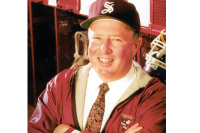Savage salvation
The Hour I First Believed by Wally Lamb. HarperCollins, 2008. 752 pages.
Wally Lamb’s newest novel, The Hour I First Believed (HarperCollins Publishers, ISBN (978-0-06-039349-6, $29.95) opens with a quotation from Dante’s Inferno: “And so, they moved over the dark waves, and even before they disembarked, new hordes gathered there.” The quotation may remain obscure in terms of the novel, but a selection from the Inferno to introduce this important novel is entirely appropriate, as Lamb deals with the shooting at Columbine High School and the aftermath of devastation it left among the survivors.
Caelum Quirk and his wife Maureen leave Connecticut and Caelum’s tormented past to take jobs — Caelum as a teacher, Maureen as a school nurse — at Columbine High School in Littleton, Colo., where both hope to make a new start in their lives and in their marriage. In April 1999, Caelum returns home to stand beside the hospital bed of his dying, stroke-crippled aunt, a strong humorous woman who helped raise him. While Caelum is away, two students, Eric Harris and Dylan Klebold, enter the high school and randomly massacre students and faculty, focusing in particular on the library where, as it develops, Maureen has hidden herself in an empty cabinet, listening to the gunshots, screams, and cries for mercy from the students hiding beneath tables and chairs.
Those of us who have escaped such horrific tragedies in our own lives may not have stopped to imagine what such insanity and murder might do to the survivors. Lamb gives us such a victim in Maureen, a character tormented by her survival, a woman whose fixation on the evil that entered her life that day may astound, baffle, and even exasperate readers. Lamb largely shapes Maureen for us through Caelum’s eyes, letting us understand what has befallen her even while, like Caelum, we sometimes can’t understand why Maureen reacts as she does in the wake of the murders.
Lamb’s recreation of the massacre is immediate and vividly written. He has studied the journal excerpts, notes, and videotapes left behind by the killers. He also relies on first-hand accounts and, of course, his own rich imagination to create scenes like this one:
“Maureen said she saw them enter, carrying duffel bags, the tall one in a long black coat, the shorter one in a white T-shirt and cargo pants tucked inside his boots. He was carrying a shotgun. He looked at her, grinning. Eric, his name was. Luvox, 75 milligrams at lunchtime. ‘Get up!’ he shouted. ‘All the jocks stand up! We’re going to kill every single one of you!’
Related Items
‘Anyone with a white hat, stand up!’ the other one shouted. ‘Are you guys scared? Well, don’t be, because you’re all going to die anyway!’
... She heard screaming, pleas, the crack of gunfire, shattering glass. ‘How about it, big boy? You want to get shot today?... Hey, you? Peekaboo!’
... Over the alarm, she could hear their taunts, the ridiculing of their victims before the shotgun blasts. It was as if each of the shots passed through her, she said. She knew they’d find her. She was sure she was going to die — that this cabinet would be her coffin.”
By the end of the summer, both Caelum and Maureen abandon the nightmare that has become Littleton to return to Three Rivers, Conn. Caelum takes over his Aunt Lolly’s farmhouse and buckles down to several years of intense labor, working as a baker and an adjunct instructor at the community college to pay for Maureen’s medical bills while at the same time having to endure her despair and emotional depression. Eventually, Maureen returns to work as a nurse, this time in a retirement home, only to once again find herself in the middle of tragedy and personal doom. How she and Caelum face yet more fires of their own personal inferno finishes out the novel.
The Hour I First Believed, however, is much more than a replaying of the shootings at Columbine. The secondary characters here are vital to the plot and theme of the book. Velvet Hoon, a lost, freakish teenager whom Maureen takes under her wing (she calls Maureen ’Mom’ through much of the book), floats in and out of the Quirks’ lives, always on the verge of falling back into her old life of prostitution and abuse, yet providing both Maureen and Caelum with odd friendship and at times an acerbic love. Alphonse Buzzi, Caelum’s best friend from adolescent, demonstrates again and again his own loyalty to Caelum, using his hard-edged humor as a sword against the threatening mental darkness.
Friendship and family, it turns out, are as much a focus of this powerful story as disaster and savagery. Back in Three Rivers, Caelum slowly comes to understand the mystery of his own family: the apparent coldness of his mother, the dissolution of his father, the idealism and steel will of several of his female ancestors. Through the discovery of a journal, letters, and newspaper accounts, he is finally able to make sense of a past which for his entire life had eaten his pleasure and fed him despair.
The Hour I First Believed is a sprawling novel — it runs more than seven hundred pages — with a half dozen major themes. Yet the final message of the book is clear. “What does not kill me makes me stronger,” a man once wrote, and in the case of Caelum, the spiritual beatings he has taken, the losses he has born, the truths he has discovered, do indeed make him stronger, not in the ways we normally think of strength — power, might, force — but stronger in the ways and wiles of love.









